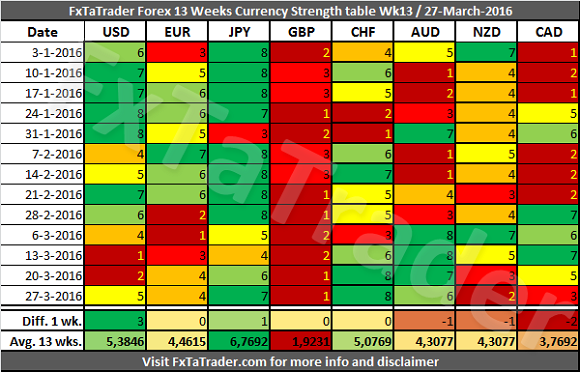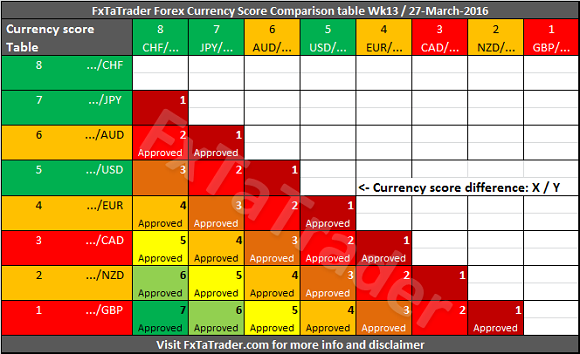This is the article "Strength and Comparison" for the coming week, the article "Ranking, Rating and Score" has also been published this weekend.
For analyzing the best pairs to trade looking from a longer term perspective the last 3 months currency classification can be used as support.
This is updated during this weekend and provided here for reference purposes only:
Strong: USD / JPY / CHF. The preferred range is from 6 to 8.
Average: EUR, AUD, NZD. The preferred range is from 3 to 5.
Weak: GBP, CAD. The preferred range is from 1 to 2.
The charts are provided in the following article: "Forex Currency Score Classification for Wk13".
13 Weeks Currency Score Strength for Week 13 / 27-March-2016
The 13 Weeks Currency Strength and the 13 Weeks Average are provided here below. This data and the "3 months currency classification" are considered for deciding on the preferred range. Because it is not ideal nor desired to change the range for a currency every single week, we perform several checks to avoid this.
- First of all the 13 weeks average and the strength over a period of 13 weeks. Both the average and the strength are shown in the table below.
- The amount of weeks that a currency is stronger than another currency can also be evaluated.
- Besides these the "13 weeks currency classification" chart of each currency is also consulted. These have been updated and can be found in the following article: "Forex Currency Score Classification for Wk13".

As can be seen the CHF gained a lot of strength lately being 9 of the 13 weeks stronger than the NZD and having a higher average also. That is why the CHF and the NZD switched places in the "Forex Currency Score Classification for Wk13" provided this weekend.
Currency Score Comparison for Week 13 / 27-March-2016
"Comparison table" and the "Ranking and Rating list" The Forex Currency Comparison Table compares each Currency with its counterpart based on the Currency Score. For more information about the currency Score of this week you can read the article "Forex Ranking, Rating and Score" which is published every week together with this article.
By using the comparison table here below you get a view without the volatility and statistics as opposed to the "Ranking and Rating list". Only the strength of each currency against the counterparts is analyzed by using the Technical analysis charts of the 4 Time Frames that are also used for the "Ranking and Rating List".
The information from the Comparison Table is the source for calculating the "Ranking and Rating List" where this list uses additionally the volatility and statistics for creating the best and worst performer in the list from number 1 to 28.
"Comparison table" and the "Currency Score Chart" The additional analysis of this table compared to the Currency Score table is that the Comparison table compares the strength between the currencies of each pair. By subtracting the strength of the weaker currency from the stronger currency we have a way to compare each pair combination.
The comparison table provides a way to compare currencies from a longer term perspective of 13 weeks and also simultaneously taking the current trend into account. By coloring the currencies in the X and Y axis according to their Classification, we can show what the best combinations are. In doing this we apply 2 rules to make it clear.
- First of all only better classified currencies in combination with weaker classified currencies are "Approved".
- The only exception is when 2 currencies are similarly classified but the Currency Score difference is equal to or more than 4.
- It means that each currency must be far apart from each other in the range from 1 to 8. This means that the classification of the currencies in question may change in the longer term. By using the difference of 4 which is exact the half of the range it seems a safe approach for trading 2 currencies similarly classified.
- Since each classification covers only 2 or 3 scores at the most it means that the currencies should be at least one classification apart from each other in the current week.
- Even though they are in the same classification when looking at the 13 weeks average a currency may be in a weaker/stronger period and may even change its classification in the future. See the current classification for the coming period at the top of this article.
Putting the pieces together
The article "Ranking, Rating and Score" published this weekend with the "Ranking and Rating List" contains the following interesting pairs
Based on the last "3 months currency classification" and the "Currency Comparison Table" the most interesting currencies for going long seem to be theCHF, JPY and AUD. These are strong or average currencies from a longer term perspective when looking at the last "3 months currency classification". For going short the same analysis can be done and theCAD, NZD and the GBP seem to fit the best. These are average or weak currencies from a longer term perspective.
Some of these pairs comply for a longer term trade based on the Daily and Weekly chart. We will look at these ones here in a bit more detail. The ones that do not comply may be more interesting for the short term. See the article "Ranking, Rating and Score" for more details.
- A crossed join between the best pairs in the "Ranking and Rating List", the "Currency Comparison Table" and the pairs with the best charts mentioned here above shows that the EUR/GBP long and the EUR/JPY short are not included in the "Ranking and Rating List". These are pairs with a low Ranking of 11 and 27 but these are interesting pairs in the "Currency Comparison Table" and are pairs to watch too.
Disclaimer: The article is my personal opinion, not recommendations, FX trading is risky and not suitable for everyone.The content is for educational purposes only and is aimed solely for the use by ‘experienced’ traders in the FOREX market as the contents are intended to be understood by professional users who are fully aware of the inherent risks in forex trading. The content is for 'Forex Trading Journal' purpose only. Nothing should be construed as recommendation to purchase any financial instruments. The choice and risk is always yours.
